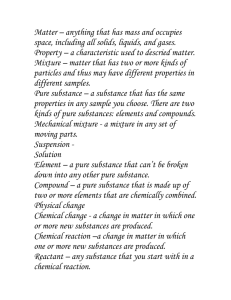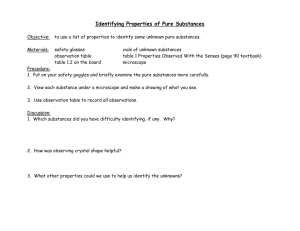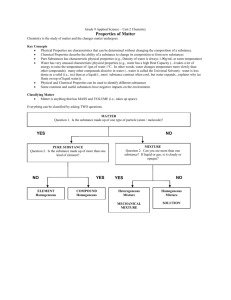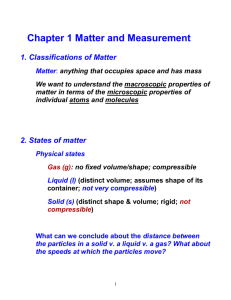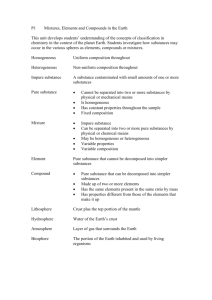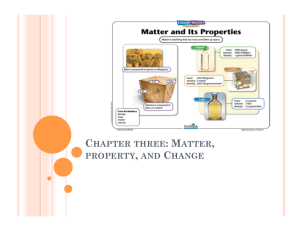Properties of Matter
advertisement
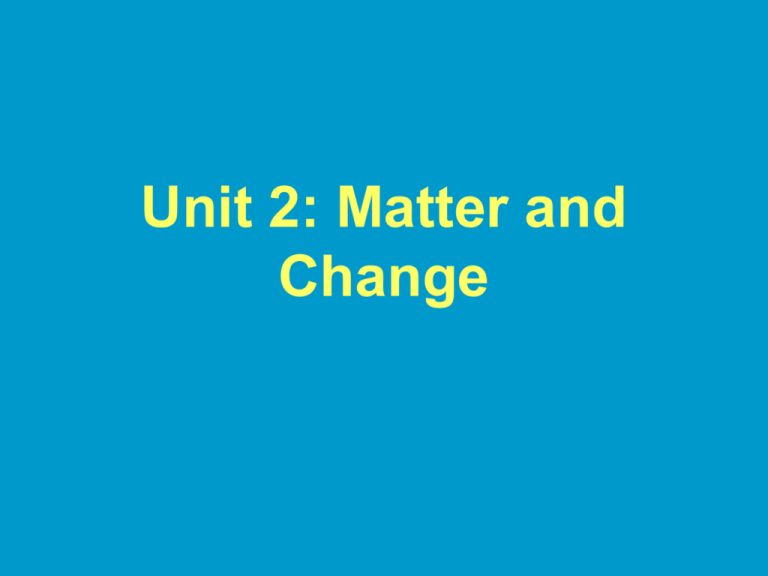
Unit 2: Matter and Change OBJECTIVES Students will be able to: 1. define matter 2. describe the states of matter (solid, liquid, gas) 3. identify the characteristics of of a substance, element and compound 4. distinguish between physical and chemical change 5. identify properties of matter (chemical, physical, intensive, extensive) 6. identify changes in matter that occur (physical and chemical change) 7. explain the law of conservation of mass WHAT IS MATTER? • Matter is anything that takes up space and has mass • Matter or not? – gold – sound – sunlight – air – water – heat – thoughts QuickTime™ and a decompressor are needed to see this picture. MASS & WEIGHT • Mass is the measure of the amount of matter that makes up an object • Weight is a measure of the force of gravity on an object – weight = mass x gravity – weight varies depending on distance from the earth’s surface • Because the value never changes, scientists use mass, not weight to measure matter STATES OF MATTER Shape Takes the shape of container Takes the shape of container Definite shape Volume Fills volume of container Definite volume Definite Volume Arrangement of particles Random, far apart Random, close Fixed, close Attraction between particles Essentially none Strong Very strong GAS vs. VAPOR • Gases and vapors are similar, but terms should not be used interchangeably – Gas refers to a substance that is naturally in the gaseous state at room temperature: hydrogen gas – Vapor refers to the gaseous state of a substance that is a solid or a liquid at room temperature: water vapor THE PHASES OF WATER solid liquid gas Matter Anything that has mass and takes up space Pure Substance Matter with an unique and unchanging composition Element Pure substance that chemical cannot be change broken into more simpler substances Mixtures physical change Compound Atoms of two or more elements that are chemically united in a fixed proportion A combination of 2 or more pure substances Homogeneous Mixture/Solutio n Mixture with a uniform composition Heterogeneo us Mixture Mixture does not appear to be the same throughout (PURE) SUBSTANCE • A substance is a form of matter with an unique and unchanging composition (composition doesn’t change from sample to sample) • Examples: Water, salt • What about salt water? • All pure substances are either elements or compounds ELEMENT • An element is a substance that cannot be broken into more simpler substances • Examples: gold (Au), oxygen (O2) • To date, there are 118 elements QuickTime™ and a decompressor are needed to see this picture. COMPOUNDS • Compounds are substances composed of atoms of two or more different elements that are chemically united in a fixed proportion – Water (H2O), sugar (sucrose, C12H22O11), ammonia (NH3) • Compounds can be separated back into its elements (by chemical means) – Electrolysis of water: • 2H2O 2H2 + O2 QuickTime™ and a decompressor are needed to see this picture. PROPERTIES OF MATTER • Every pure substance has a unique set of properties • A property is a characteristic that allows us to recognize a certain type of matter Physical properties of water clear liquid at room temperature boils at 100oC freezes at 0oC density at 4oC is 1.000 g/cm3 PHYSICAL PROPERTIES • Physical properties are those properties that can be measured without changing the identity of the substance: – color, odor, melting point, boiling point, density, hardness, taste • Physical properties are either extensive or intensive Extensive property Intensive property •A property that depends on the amount of a substance present •Example: Mass, volume, length •value will change when the amount of substance changes: 1 mL of water has a mass of 1 g while the mass of 1 L has a mass of 1000 g •A property that is independent of the amount of substance present •Example: Density, boiling point, melting Point •value will not change when the amount of substance changes: The density of water is always 1.00 g/mL CHEMICAL PROPERTIES • Chemical properties describe the way a substance may change or react to form other substances – Corrosion, flammability • The inability of a substance to change is also a chemical property – Argon gas is inert • To observe a chemical property a chemical change must occur QuickTime™ and a decompressor are needed to see this picture. PROPERTIES OF COPPER Physical properties reddish brown, shiny good conductor of heat Chemical properties Forms a green copper carbonate compound when in contact with moist air Forms new substances when combined with nitric & sulfuric acid Density = 8.92 g/cm3 Melting point = 1085oC Boiling Point = 2570oC Forms deep blue solution when in contact with ammonia CHANGES IN MATTER • A physical change is a change that alters the appearance of the substance drastically but leaves its composition unchanged: – bend, grind, split, crush, boil, freeze, melt, vaporize Chemical Change (Chemical Reaction) • In a chemical change a substance is transformed into a chemically different substance – When hydrogen burns in air it reacts with oxygen to form water • The new substances formed have different compositions and different properties • Terms: Explode, rust, oxidize, corrode, tarnish, ferment, burn, rot etc. EVIDENCE OF CHEMICAL CHANGE Formation of a gas or solid; color change; energy change; odor PHYSICAL OR CHEMICAL CHANGE? • Plants use carbon dioxide and water to make sugar. • On a cold day, water vapor in the air forms frost. QuickTime™ and a decompressor are needed to see this picture. THE LAW OF CONSERVATION OF MASS • Mass (matter) is neither created nor destroyed during a reaction…mass is conserved: Massreactants = Massproducts 2HgO 2Hg + O 216 g 200 g + 16 g reactants products PRACTICE PROBLEM 1. In a complete reaction of 22.99 g of sodium with 35.45 g of chlorine, what mass of sodium chloride is formed? 2. A 12.2-g sample of X reacts with a sample of Y to form 78.9 g of XY. What is the mass of Y that reacted?
